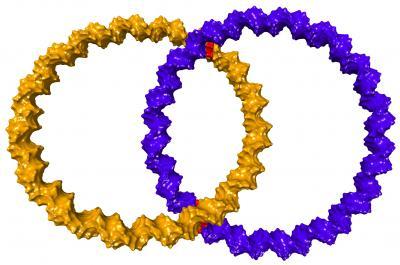FRANKFURT. Creating artificial structures from DNA is the objective of DNA nanotechnology. This new discipline, which combines biology, physics, chemistry and material science makes use of the ability of the natural DNA-strains' capacity for self assembly. Smileys or small boxes, measuring only 10s of nanometers (10 one-billionths of a meter) were created from DNA in a drop of water. Prof Alexander Heckel and his doctoral student Thorsten Schmidt from the "Cluster of Excellence for Macromolecular Complexes" at Goethe University were able to create two rings of DNA only 18 nanometers in size, and to interlock them like two links in a chain. Such a structure is called catenan, a term derived from the Latin word catena (chain). Schmidt, who got married during the time he was working on the nano-rings, believes that they are probably the world's smallest wedding rings.
From a scientific perspective, the structure is a milestone in the field of DNA nanotechnology, since the two rings of the catenan are, as opposed to the majority of the DNA nanoarchitechtures that have already been realized, not fixed formations, but – depending on the environmental conditions – freely pivotable. They are therefore suitable as components of molecular machines or of a molecular motor. "We still have a long way to go before DNA structures such as the catenan can be used in everyday items", says Prof Alexander Heckel, "but structures of DNA can, in the near future, be used to arrange and study proteins or other molecules that are too small for a direct manipulation, by means of auto-organization." This way, DNA nano-architectures could become a versatile tool for the nanometer world, to which access is difficult.
In the manufacture of DNA nano-architecture, the scientists take advantage of the pairing rules of the four DNA nucleobases, according to which two natural DNA strands can also find each other (in DNA nano-architecture, the base order is without biological significance). An A on one strand pairs with T on the other strand and C is complementary to G. The trick is to create the sequences of the DNA strands involved in such a manner as to ensure that the desired structure builds up on its own without direct intervention on the experimenter's part. If only certain parts of the strands used complement each other, branches and junctions can be created.

The world's smallest wedding rings are built up by two interlocked DNA-strands.
(Photo Credit: Alexander Heckel)
As reported by Schmidt and Heckel in the journal "Nano Letters" (online advance publication, dx.doi.org/10.1021/nl200303m), they first created two C-shaped DNA-fragments for the catenans. With the help of special molecules that act as sequence-specific glue for the double helix, they arranged the "Cs" in such a ways as to create two junctions, with the open ends of the "Cs" pointing away from each other (see images). The catenan was created by adding two strands that attach to the ends of the two ring fragments, which are still open. Thorsten Schmidt dedicated the publication to his wife Dr Diana Gonçalves Schmidt, who also appreciates the work on scientific level, since she was also a part of Alexander Heckel's work group.
Since they are much smaller than the wavelengths of visible light, the rings cannot be seen with a standard microscope. "You would have to string together about 4000 such rings to even achieve the diameter of a human hair", says Thorsten Schmidt. He therefore displays the catenans with a scanning force microscope, which scans the rings that have been placed on a surface with an extremely fine tip.
Source: Goethe University Frankfurt